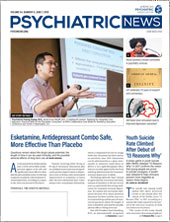The Risk Evaluation and Mitigation Strategy (REMS) program begun in 2011 for transmucosal immediate-release fentanyl medications did not have as great an impact as intended, a study in JAMA Network Open suggests. Although prescriptions initially dropped during the first year of the program, they had returned to near pre-REMS levels by the end of 2014.
William Fleischman, M.D., M.H.S., director of quality and implementation science at Hackensack Meridian Health, and colleagues assessed prescribing of transmucosal immediate-release fentanyl (TIRF) by analyzing prescription claims data submitted to Medicare Part D for 2010 through 2014. The main outcome measures were TIRF prescription fills per 100,000 Medicare Part D beneficiaries. They also assessed prescribing for patients with no known opioid tolerance.
They found that although TIRF medications are approved for treating breakthrough pain in cancer patients who are tolerant to other around-the-clock opioid analgesics, 72% of the prescriptions in the study period were for patients who did not have cancer, and 79% of the prescriptions were for people younger than age 65. Overall, prescriptions for TIRF products represented only 0.03% of all opioid prescriptions.
That so many prescriptions were written off label should raise an alarm regarding certain Medicare populations, Fleischman told Psychiatric News.
“Patients younger than 65 in the Medicare population tend to be in two groups: those with end-stage renal disease or disability,” said Fleischman, who was an employee of the Centers for Medicare and Medicaid Services at the time of the study. “That should alert people to focus on those two populations as being at high risk of opioid overdose and who may potentially get inappropriate prescriptions for these medications.”
For 2010 through 2012, TIRF prescribing decreased by 1% per month. However, beginning in mid-2013 (the year after the REMS program took effect), TIRF prescribing rose 2% each month and had approached pre-REMS levels by the end of the study in 2014.
“One explanation for the observed attenuation of the decrease in prescribing associated with the program could be that it may have taken a year for patients, prescribers, and pharmacists to familiarize themselves with REMS requirements and to register and complete the educational program,” Fleischman and colleagues wrote. “However, the subsequent return to baseline prescribing levels occurred despite a persistent decrease in the number of prescribers. This points to other possible contributing factors to the subsequent return of increased TIRF prescribing.”
For the years 2010 through 2012, a mean of 30% of initial TIRF prescriptions were for patients without known opioid tolerance. After the REMS was implemented, the number of prescriptions filled by patients without known opioid tolerance dropped 22.5%, followed by a 1.98% decrease each month for the remainder of the study. This outcome suggests that for this population, at least, the REMS program had a lasting impact.
Andrew J. Saxon, M.D., chair of APA’s Council on Addiction Psychiatry, who was not involved in the study, urged most psychiatrists to avoid prescribing TIRF products. “Except for consultation-liaison psychiatrists working in oncology settings or psychiatrists working in palliative care, psychiatrists would be best advised not to prescribe immediate-release transmucosal fentanyl products,” said Saxon.
“If general psychiatrists are treating patients for psychiatric disorders who do not have cancer and who are receiving these formulations from another provider, these psychiatrists would be well advised to contact the prescriber to discuss the appropriateness of the prescription and to be cautious in their own prescribing of medications, such as benzodiazepines or stimulants, that could result in untoward drug-drug interactions with these fentanyl products,” Saxon added.
In March, the FDA announced changes to the TIRF-REMS program that are designed to increase documentation for verifying appropriate prescribing and include a patient registry for monitoring serious adverse events (see sidebar).
Saxon feels that the changes may lead to less inappropriate prescribing.
“Prescribers who are using these products off label might consider the appropriateness more carefully if they know that their patients will be listed on a registry and the outcomes scrutinized,” Saxon said.
Fleischman is less optimistic about the REMS changes.
“The FDA has no authority to stop prescribing off label. Instead, they have the authority to crack down on companies that market off-label use. But this can be very hard to prove and pursue,” Fleischman said.
Fleischman called for swifter regulatory action going forward.
“There should be real-time monitoring of REMS programs with aggressive intervention when things are not turning out the way they should,” Fleischman said. “This REMS was implemented in 2012, and we are just now changing it in response to data that were available several years ago. We shouldn’t have to wait seven years [for action] when we see a program isn’t working.” ■
“Association of a Risk Evaluation and Mitigation Strategy Program With Transmucosal Fentanyl Prescribing” can be accessed
here.

